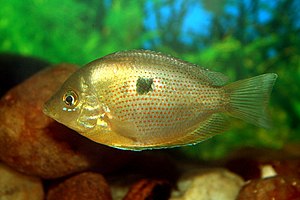Indian cichlid
| Indian cichlid | ||||||||||||
|---|---|---|---|---|---|---|---|---|---|---|---|---|

Indian cichlid, caught from the Bharathapuzha , a river in the southern Indian state of Kerala . |
||||||||||||
| Systematics | ||||||||||||
|
||||||||||||
| Scientific name of the genus | ||||||||||||
| Pseudetroplus | ||||||||||||
| Bleeker , 1862 | ||||||||||||
| Scientific name of the species | ||||||||||||
| Pseudetroplus maculatus | ||||||||||||
| ( Bloch , 1795) |
The Indian cichlid ( Pseudetroplus maculatus ( Lat . "Maculatus" = speckled), syn .: Etroplus maculatus ), also called spotted cichlid , occurs in coastal freshwater and in light brackish water in southern India and Sri Lanka .
features
It has a disc-shaped, very high back and laterally strongly flattened body and is 8 to 9 centimeters long. The relatively small mouth is terminal. The basic color of the fish is yellow. The Indian cichlid is patterned by longitudinal rows of small red dots and a large black spot slightly above the middle of the body. The dorsal fin is orange, lined with red and covered with gold-red or bright red points. The anal and caudal fin are yellowish, the front of the anal fin is lined with black. The first ray of the pelvic fins is iridescent in light blue, as is a row of scales below the eyes. The sexes are difficult to distinguish. Females are often a bit smaller. Outside the spawning season, the fish are darker and paler in color.
Fins formula : dorsal XVII – XX / 8–10, anal XII – XV / 8–9, pectoral 15–16. Scale formula : mLR 35–37.
Morphologically , the Indian cichlid differs from the two other South Asian cichlid species ( Etroplus canarensis and E. suratensis ) and the like. a. by eleven ( vs. 12–13) thoracic ribs and 26 to 27 vertebrae (vs. 28–29). In addition, the front half of the central suture between the lower pharyngeal jaw in Indian cichlid sawn (vs. smooth), the first six Pterygiophoren the anal fin are the first three (vs. 2) Hämaldornen , an outgrowth of the supraoccipital-exoccipital (bone on the Cranial base) extends ventrally halfway over the foramen magnum (large occipital opening) (vs. does not overlap the foramen magnum) and three-pointed and pointed anterior jaw teeth (vs. single-pointed and spade-shaped).
Way of life
The Indian cichlid is found in small rivers, estuaries and lagoons and often hides under roots or between fallen leaves. It feeds on zooplankton , young fish and algae. Indian cichlids are substrate spawners who attach their clutch of 200 to 300 eggs openly to stones or pieces of wood. The fish form a parent family , both parents take care of the eggs and young fish. After hatching, the larvae are housed in a hollow in the bottom of the water. In aquariums it has been observed that the fry peck at the sides of the parent animals. It is assumed that, like the young of the discus fish , they ingest particles from the parental epidermis, but here only as additional food.
literature
- Günther Sterba : The world's freshwater fish. 2nd Edition. Urania, Leipzig / Jena / Berlin 1990, ISBN 3-332-00109-4 .
- Anton Lamboj : Etroplus maculatus (Bloch, 1795). In: Claus Schaefer, Torsten Schröer (Hrsg.): The large lexicon of aquaristics. Eugen Ulmer, Stuttgart 2004, ISBN 3-8001-7497-9 , p. 368.
Individual evidence
- ↑ a b Pethiyagoda, R., Maduwage, K. & Manamendra-Arachchi, K. (2014): Validation of the South Asian cichlid genus Pseudetroplus Bleeker (Pisces: Cichlidae). Zootaxa , 3838 (5): 595-600. doi: 10.11646 / zootaxa.3838.5.9
Web links
- Indian cichlid on Fishbase.org (English)
- Etroplus maculatus in the Red List of Threatened Species of the IUCN 2013.2. Listed by: Abraham, R., 2011. Retrieved February 8, 2014.